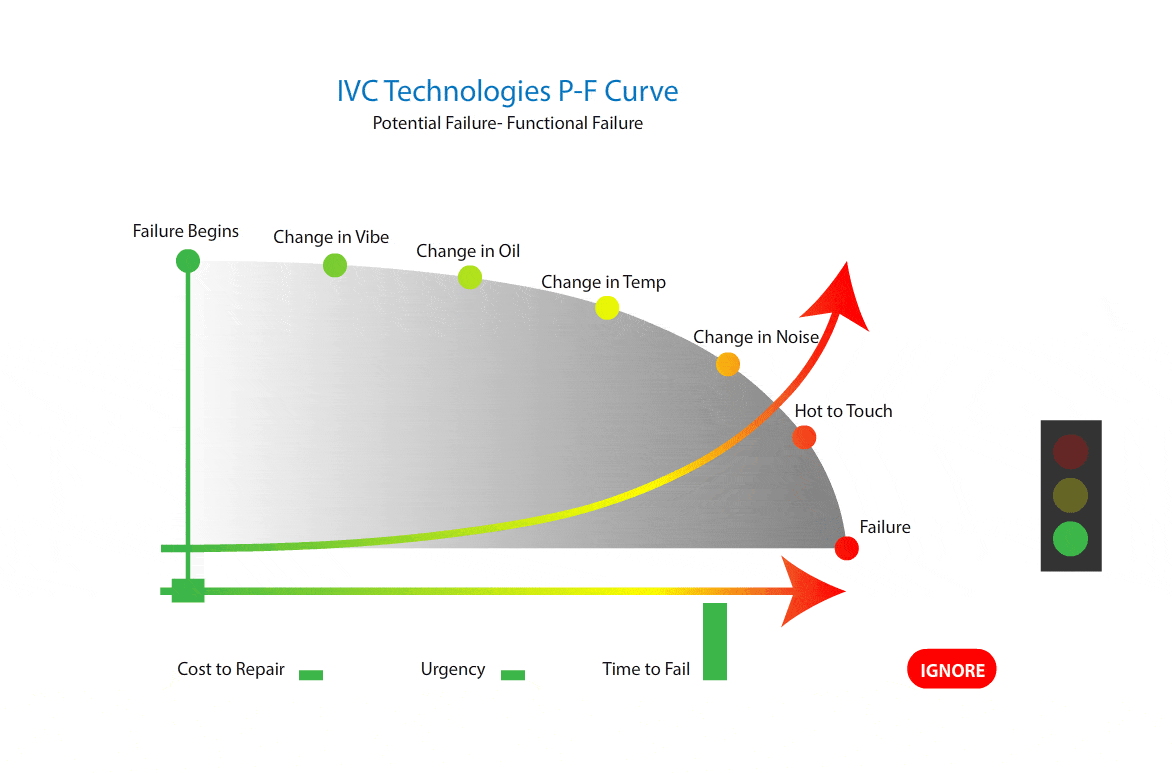Machine maintenance would be a whole lot easier and a lot less costly if failure modes were all age-related. Unfortunately, most are not. However, the good news is that most failure modes do give off warning signals that they are in the process of occurring or are about to occur.
If evidence is found that a machine is in the early stages of failure, it may be possible to take action to prevent a more costly and potentially catastrophic event. This can also prevent the associated consequences such as lost production and impact on quality should the failure occur.
That is essentially the purpose of Condition Based Maintenance (CBM) – detecting physical evidence in the early stages that a failure is occurring. While many condition monitoring techniques are most often associated with rotating equipment, when thought of as an overall maintenance strategy, CBM has much broader applications.
An important concept associated with Condition Based Maintenance is the P-F curve as shown in the animated figure below:

The curve shows that as a failure starts to manifest, the equipment deteriorates to the point at which the issue can possibly be detected (point “P”). If the failure is detected but not addressed (i.e. ignored), it will continue to deteriorate until the machine decides to schedule its own maintenance and a catastrophic functional failure occurs (point “F”). It should be noted that if the repair scheduling is left up to the machine and not the maintenance planners, it will typically occur at the worst possible time, running the most critical product when the key people and parts required to fix it are not available.
The time range between the two points is referred to as the P-F interval. This is the window of opportunity during which closer inspection could possibly detect the imminent failure and allow time to address it in a more controlled and cost-effective manner. As the diagram indicates, the longer a machine problem is left to “brew” the costlier it becomes to repair.
CBM as a maintenance strategy
As a maintenance strategy, CBM does not reduce the likelihood of a failure occurring, nor does it fix machines or stop failures from happening. Instead, it is aimed at intervening before the functional or catastrophic failure occurs with the premise that this is much more economical and should have significantly less of an impact on availability.
A common “rule of thumb” exists that the interval between CBM tasks should be one-half or one-third of the P-F interval.
However, based on our 35 years of experience in the field of condition monitoring, there is not a “one size fits all”, defined time period from “P” to “F”. In reality, it’s quite hard to quantify the exact periodicity of a P-F interval.
For example, If the MTBF (Mean Time Between Failure) is 60 days then a quarterly inspection will miss a lot of problems. However, if the MTBF is 60 months, then a monthly program may be overkill.
That’s why we recommend:
- Monthly for most assets we inspect with vibration analysis and quarterly for oil and visual
- Semi-annual or annual for ultra-sonic and electrical infrared (this covers most failure modes with scheduled route-based CBM tests)
- For critical assets where MTBF numbers are varied and the cost of the asset is expensive, then we would take a look at some sort of continuous monitoring system
For CBM to be effective as a strategy, early intervention is essential and the use of predictive technologies is the key. This requires an efficient process for gathering data, analyzing, decision making and lastly, intervention.
Whether your current CBM program just needs a tune-up or you’re in need of a completely new program, IVC Technologies can help. Contact us today.
